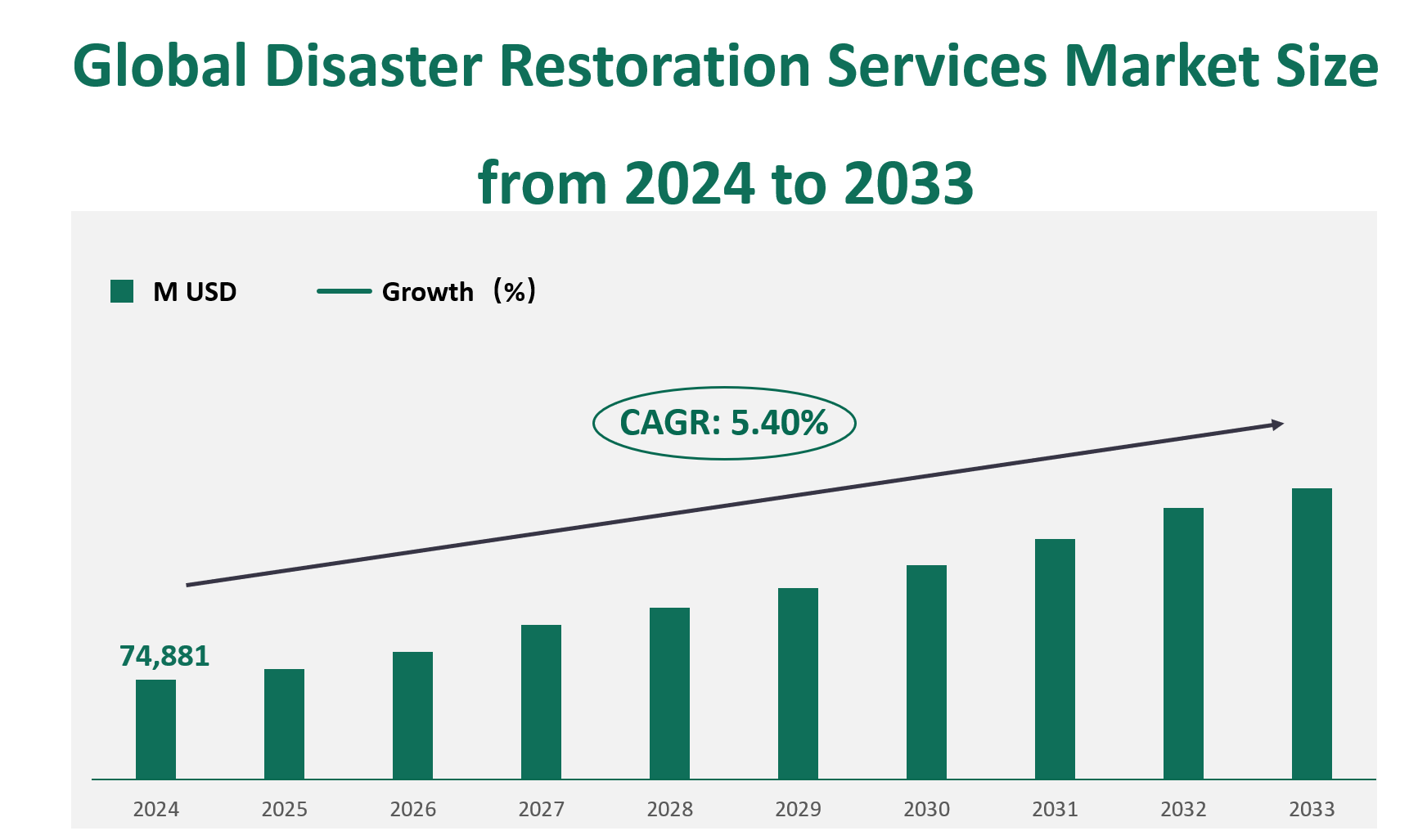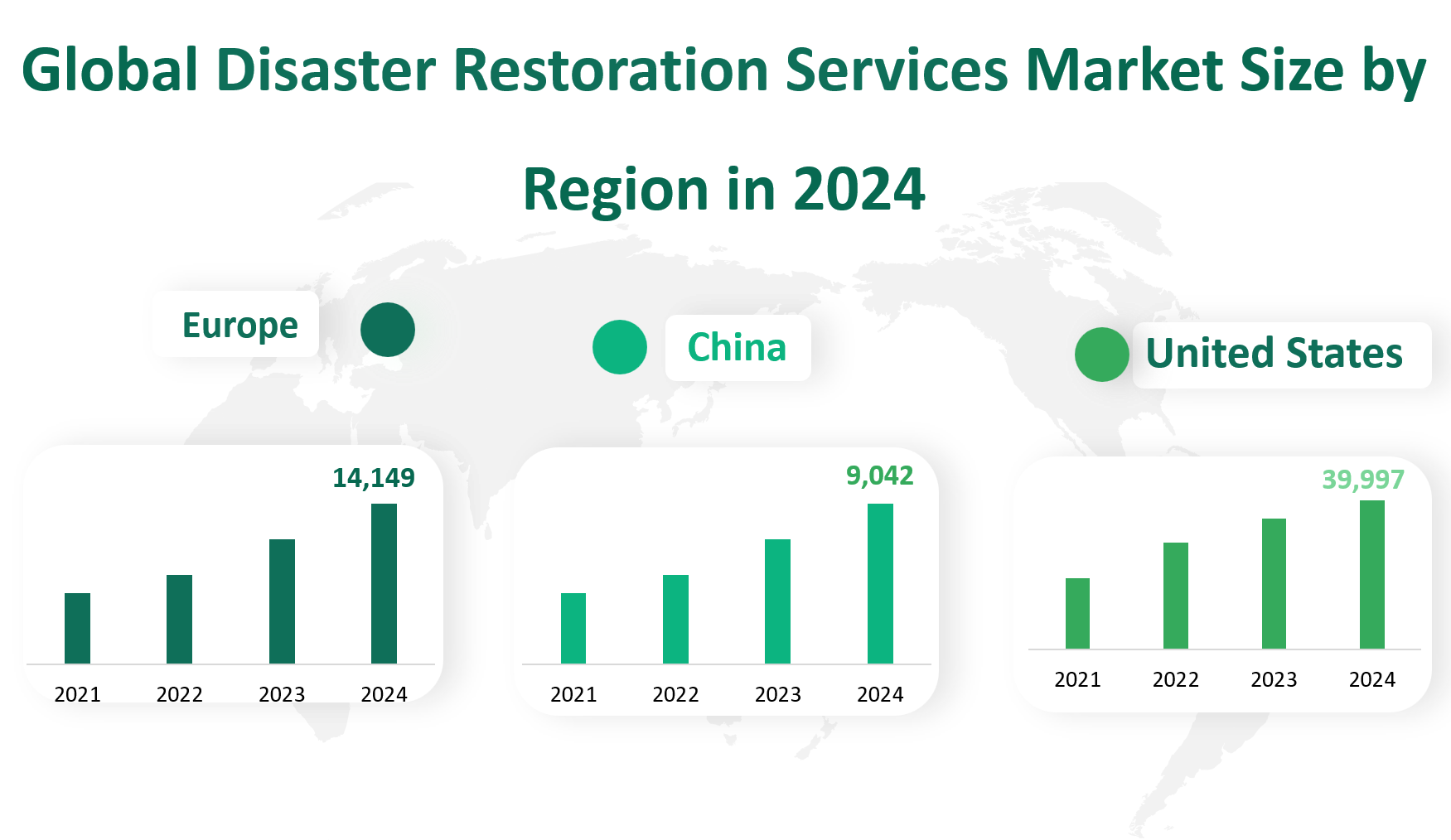1. Global Disaster Restoration Services Market Insight Analysis
Disaster restoration services is the process of cleaning and restoring the property to its original pre-disaster condition. Disaster restoration services provide remediation solutions for damaged property and structures caused by flood, fire, storm, heavy rain, mold growth and so on.
The global Disaster Restoration Services market revenue is projected to reach $74,881 million in 2024. This growth is driven by a compound annual growth rate (CAGR) of 5.40% from 2024 to 2033.
Figure Global Disaster Restoration Services Market Size (M USD) and CAGR (2024-2033)

2. Disaster Restoration Services Market Growth Drivers and Restraints
The growth of the Disaster Restoration Services market is influenced by several key factors. One of the primary drivers is the increasing frequency and severity of natural disasters due to climate change. Rising global temperatures have led to more extreme weather events such as hurricanes, floods, and wildfires, resulting in significant property damage. This surge in disaster occurrences has created a higher demand for professional restoration services.
Technological advancements have also played a significant role in driving market growth. Innovations in equipment and techniques have improved the efficiency and effectiveness of restoration processes. For example, advanced moisture detection tools, digital imaging, and specialized cleaning technologies have enabled restoration companies to provide more accurate assessments and faster recovery times. Additionally, the integration of digital platforms and software solutions has streamlined operations, enhancing communication and project management capabilities.
However, the market also faces several limiting factors that can hinder growth. One major challenge is the high cost of equipment and skilled labor. Restoration services require specialized tools and trained professionals, which can be expensive to acquire and maintain. This cost factor can limit the profitability of smaller companies and deter new entrants from entering the market.
Another limiting factor is the economic impact of disasters. While disasters create demand for restoration services, they also lead to economic disruptions and financial strain on affected individuals and businesses. This can result in reduced spending on non-essential services, including some restoration projects. Furthermore, regulatory changes and insurance policies can affect the demand for restoration services, as they influence the availability of funds for property repairs and renovations.
3. Technological Innovation in the Disaster Restoration Services Market
Technological innovation is a key factor shaping the Disaster Restoration Services market. Companies are increasingly adopting advanced technologies to enhance their service offerings and operational efficiency. For instance, the use of drones for aerial assessments has become more prevalent, allowing for quicker and more accurate evaluations of large-scale disasters. This technology enables restoration professionals to access hard-to-reach areas and gather comprehensive data on the extent of damage.
Artificial intelligence (AI) and machine learning are also being integrated into restoration processes. AI-powered software can analyze data from various sources, such as satellite imagery and sensor readings, to predict potential risks and optimize restoration strategies. This predictive capability helps companies to better prepare for disasters and allocate resources more effectively.
Furthermore, collaborations between restoration companies and insurance providers are becoming more common. These partnerships aim to streamline the claims process and improve the overall customer experience. By working closely with insurance companies, restoration firms can ensure that their services are aligned with the needs of policyholders and insurers, leading to more efficient and effective restoration outcomes.
4. Global Disaster Restoration Services Market Size by Type
The disaster restoration services market is segmented into several product types, each with distinct services and market dynamics. The primary product types include Fire and Smoke Restoration, Water Damage Restoration, Wind Damage Restoration, Mold Remediation, and Others.
Fire and Smoke Restoration involves the process of cleaning and restoring properties after fire incidents, which includes debris removal, odor and soot elimination, and neutralizing toxic smoke odors. This service type generated 18490 million USD in 2024.
Water Damage Restoration focuses on mitigating the destructive results of flooding and water damage, providing immediate responses to prevent further damage. This service is crucial in regions prone to heavy rainfall and flooding. This service type generated 30432 million USD in 2024.
Wind Damage Restoration addresses the damage caused by storms, hurricanes, and other high-wind events. This includes repairing and restoring structures affected by windborne debris and structural damage. This service type generated 8170 million USD in 2024.
Mold Remediation involves the containment, cleaning, and stabilization of environments affected by mold growth, which can be a significant health hazard. This service is particularly important in damp or water-damaged buildings. This service type generated 12229 million USD in 2024.
In terms of market revenue in 2024, Water Damage Restoration is projected to hold the largest market share, reflecting the global prevalence of water-related disasters and the urgent need for mitigation services.
Table Global Disaster Restoration Services Market Size and Share by Type in 2024
Type | Market Size (M USD) 2024 | Market Share |
Fire and Smoke Restoration | 18490 | 24.69% |
Water Damage Restoration | 30432 | 40.64% |
Wind Damage Restoration | 8170 | 10.91% |
Mold Remediation | 12229 | 16.33% |
Others | 5559 | 7.42% |
Total | 74881 | 100.00% |
5. Global Disaster Restoration Services Market Size by Application
The applications of disaster restoration services are broadly categorized into Household and Commercial sectors.
Household applications refer to the restoration of residential properties affected by disasters. This includes services for individual homeowners, covering a range of disaster types from fire and water damage to mold infestations.
Commercial applications, on the other hand, pertain to the restoration of commercial and industrial properties post-disaster. This sector is vital for businesses, as it involves the rapid restoration of properties to minimize downtime and financial losses.
In 2024, the Household application is expected to dominate the market consumption value, with a revenue of $43557 million.
The Commercial application is projected to experience the fastest growth rate, reaching $31,324 million in revenue by 2024.
Table Global Disaster Restoration Services Market Size and Share by Application in 2024
Application | Market Size (M USD) 2024 | Market Share |
Household | 43557 | 58.17% |
Commercial | 31324 | 41.83% |
6. Global Disaster Restoration Services Market Size by Region
The United States emerged as the largest regional market for Disaster Restoration Services in 2024, with a market revenue of 39,997 million USD. This dominant position can be attributed to several factors, including the country’s large economy, frequent occurrences of natural disasters, and a well-developed insurance industry that often covers disaster restoration costs. The U.S. market’s size and maturity make it a crucial player in the global Disaster Restoration Services industry.
China stands out as the fastest-growing region in the Disaster Restoration Services market. In 2024, the market revenue in China reached 9,042 million USD, reflecting a significant increase from previous years. This growth is driven by China’s rapidly expanding economy, urbanization, and the increasing frequency of natural disasters due to climate change. The Chinese government’s investment in infrastructure and disaster preparedness has also contributed to the market’s expansion, making China a key region for future growth in the industry.
Europe, with a market revenue of 14,149 million USD in 2024, held the second-largest share. The region’s mature market and high demand for professional restoration services contribute to its significant market share.
Japan, with a market revenue of 3,891 million USD, and India, with 1,600 million USD, also play important roles in the global market. While their contributions are smaller compared to the U.S. and China, these regions offer unique opportunities due to their specific market conditions and growth potentials.
Figure Global Disaster Restoration Services Market Size by Region in 2024

7. Global Disaster Restoration Services Market Analysis by Major Players
The leading companies operating in Disaster Recovery Services Market are Servpr, Johns Lyng Group, Neighborly, American Technologies Inc, PuroClean, etc.
Johns Lyng Group, established in 1953, is a major player with a sales region mainly in Australia, New Zealand, and North America. The company offers comprehensive disaster management solutions, including 24/7 emergency services, pre-disaster planning, and qualified consultations. In 2022, Johns Lyng Group reported a revenue of 487.1 million USD.
Neighborly, founded in 1981, operates primarily in North America. It provides a wide range of services, including housing rehab, reconstruction, and mitigation activities. In 2022, Neighborly’s revenue was 364.7 million USD.
American Technologies Inc, established in 1989, specializes in commercial disaster restoration, helping buildings recover from catastrophic events. The company is known for its quick response and minimal business interruption. In 2022, American Technologies Inc generated a revenue of 352.2 million USD.
Servpro, established in 1967, is a well-known name in the disaster restoration industry, particularly in North America. It offers services such as fire and water damage restoration, specialty cleaning, and mold remediation. Servpro’s revenue in 2022 was 261.9 million USD.
PuroClean, founded in 2001, is another significant player in North America. Known as “The Paramedics of Property Damage®,” PuroClean offers services like water damage remediation, fire and smoke damage remediation, and biohazard cleanup. In 2022, PuroClean’s revenue reached 212.6 million USD.

